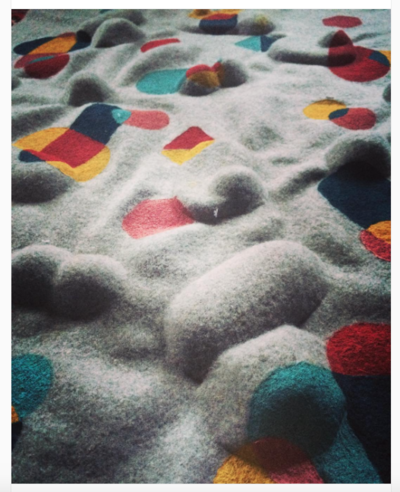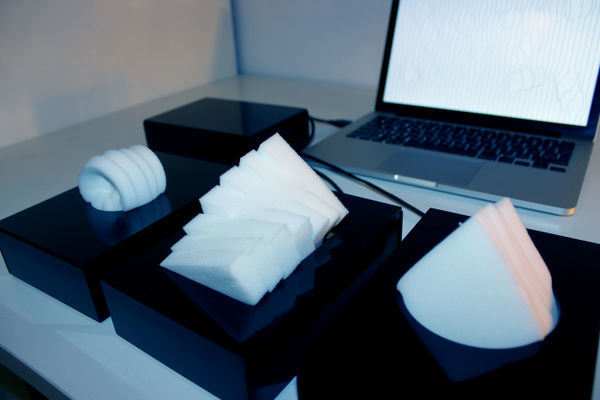Difference between revisions of "Practical/Exhibited Works"
Lucashartman (talk | contribs) |
|||
| Line 46: | Line 46: | ||
What inspired me for this project was, the way I make use of my laptop to create digital prints. This is mainly trough a mouse or trackpad, which adjusts the prints in an unnatural way. I wondered what would happen, if somehow the print could really sense touch. And how this print would respond to this. This tool-kit stimulates the relation between the maker and the digital process. It is made out of polyurethane flexible foam and is attractive to touch and play with. Sensors are build in for communication with the digital print. Functions of different hand gestures would be: flex, push, pinch, stroke, pull and so on. This way making a digital print becomes more exciting, more personal and more unique for each designer. | What inspired me for this project was, the way I make use of my laptop to create digital prints. This is mainly trough a mouse or trackpad, which adjusts the prints in an unnatural way. I wondered what would happen, if somehow the print could really sense touch. And how this print would respond to this. This tool-kit stimulates the relation between the maker and the digital process. It is made out of polyurethane flexible foam and is attractive to touch and play with. Sensors are build in for communication with the digital print. Functions of different hand gestures would be: flex, push, pinch, stroke, pull and so on. This way making a digital print becomes more exciting, more personal and more unique for each designer. | ||
| + | |||
| + | |||
| + | ---- | ||
| + | |||
| + | Lucas Hartman | ||
| + | |||
| + | '''Forge Glitch''' | ||
| + | |||
| + | [[File:mandala_glitch.JPG|600px]] | ||
| + | |||
| + | With the use of mathematical precision, Digital Art is often about perfection. | ||
| + | Crafting with the imperfection of the digital tools, can produce a strange and disorganize results. | ||
| + | This piece not about making a statement. Reorganizes the elements, helps the viewer to see object in a different way. | ||
| + | |||
| + | |||
| + | |||
| + | '''Reverse Reality Shock Treatment''' | ||
| + | |||
| + | [[File:RRST.JPG|600px]] | ||
| + | |||
| + | Reverse Reality Shock’: Its the process of re-adjusting, re-assimilating and re-acculturating to the real world. | ||
| + | Meant for people that have became custom to the virtual world. | ||
| + | The installation is developed meant as a therapeutic treatment tool for Reverse Reality Shock. | ||
Revision as of 10:00, 19 January 2016
List all of your projects here.
Please provide:
a title
an image
a short description of the project
-Lizet
-For Fantastic forgeries-
My starting point was to figure out what I miss in textile. When I went to Première Vision, a textile event I realized that al the textiles have different colours, prints and materials but we don’t have a extra layer, a 3th dimension in fabric. In my work I make that extra dimension. It’s an added value in textile, the fabric will have movement, volume and every time a different shadow.
For “Fantastic forgeries” I created a new woven technique with fabric. We choose an artwork from a exposition to copy this object in your own technique. I use the carpet of Albert Van huffel. The focus was to find a way that I can fold different layers of fabric into each other and that it would stay in the position without sewing.

- for felt it -
My starting point was to figure out what I miss in textile. When I went to Première Vision, a textile event I realized that al the textiles have different colours, prints and materials but we don’t have a extra layer, a 3th dimension in fabric. In my work I make that extra dimension. It’s an added value in textile, the fabric will have movement, volume and every time a different shadow.
For “Tools of the trade” I created a tool that is a heat press itself. With this tool you can press 3 dimension prints in textile. “Tools of the trade” is a starting point for my graduation collection. My final collection is going to be based on the concept of our rich fantasy memories and positive escapism. The stories that we believed as children and fantasy stories that we created in our head are the biggest inspiration.
Dionne Wolff
Tangible computer interface
How can the design of a tangible computer interface help to create an innovative hands on approach for textile print designers?
What inspired me for this project was, the way I make use of my laptop to create digital prints. This is mainly trough a mouse or trackpad, which adjusts the prints in an unnatural way. I wondered what would happen, if somehow the print could really sense touch. And how this print would respond to this. This tool-kit stimulates the relation between the maker and the digital process. It is made out of polyurethane flexible foam and is attractive to touch and play with. Sensors are build in for communication with the digital print. Functions of different hand gestures would be: flex, push, pinch, stroke, pull and so on. This way making a digital print becomes more exciting, more personal and more unique for each designer.
Lucas Hartman
Forge Glitch
With the use of mathematical precision, Digital Art is often about perfection. Crafting with the imperfection of the digital tools, can produce a strange and disorganize results. This piece not about making a statement. Reorganizes the elements, helps the viewer to see object in a different way.
Reverse Reality Shock Treatment
Reverse Reality Shock’: Its the process of re-adjusting, re-assimilating and re-acculturating to the real world. Meant for people that have became custom to the virtual world. The installation is developed meant as a therapeutic treatment tool for Reverse Reality Shock.

